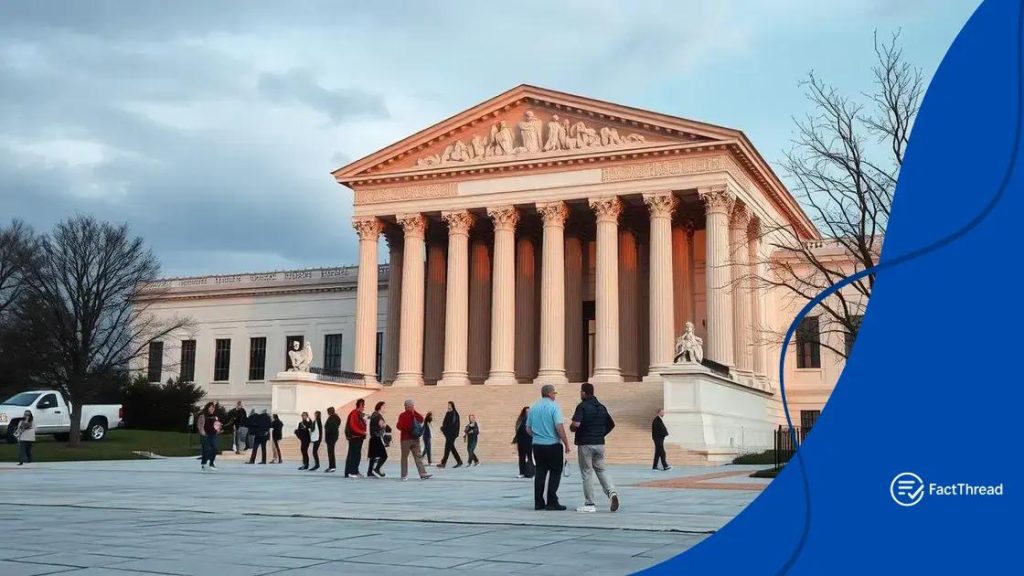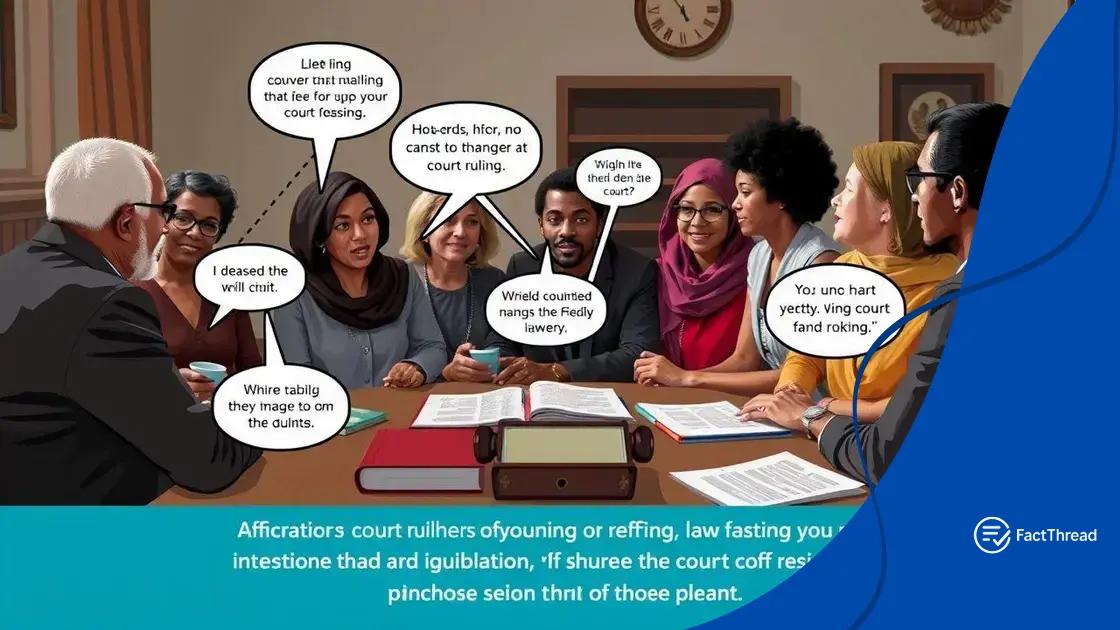Supreme Court hears major case arguments: what to expect

The Supreme Court hears major case arguments that could significantly impact laws and societal norms, driven by public reaction and historical precedents shaping future legal interpretations.
Supreme Court hears major case arguments that could have a lasting impact on our legal system. Have you ever wondered how a single case can change everything? In this article, we’ll delve into the details and what’s at stake.
Background of the case before the Supreme Court
The background of the case before the Supreme Court is crucial for understanding the arguments being presented. This case has its roots in significant legal precedents and social issues. It highlights important questions that affect many people.
Key Details Leading Up to the Case
Before entering the Supreme Court, this case went through various lower courts. Understanding the journey of this case is essential. Each court’s decision has played a role in shaping the arguments we see today.
- The origins often stem from state laws.
- Previous court rulings set significant legal standards.
- Community input and public opinions influenced the case.
- Legal experts have debated the implications of the case.
As the case progressed, the implications of the ruling became more apparent. It has raised questions about rights and regulations, indicating how much is at stake. Throughout this process, both sides have presented their arguments, highlighting the complexities of the law and its application.
Social and Legal Context
The case is not just about legal principles; it also touches on broader social issues. Many advocates see this as a pivotal moment for social change. For instance, it addresses rights that have long been disputed in society.
Moreover, the legal community is closely watching how this case unfolds. It is seen as a potential landmark ruling that could reshape future interpretations of the law. Legal scholars and practitioners are engaging in discussions about the possible outcomes and their broader implications.
In conclusion, understanding the background of this case requires examining the legal, social, and historical layers that contribute to its significance. As public interest grows, so does the anticipation surrounding the Supreme Court’s decision.
Key players involved in the arguments
Understanding the key players involved in the arguments is essential to grasping the case’s significance. Each player brings unique insights and perspectives that shape the discussions in the courtroom.
The Petitioners
At the forefront are the petitioners, who challenge existing laws or decisions. They argue that their rights have been infringed upon. Their experiences often highlight real-world issues that resonate with many.
- They present detailed evidence to support their claims.
- Legal representatives advocate passionately on their behalf.
- Petitioners may represent broad groups or specific individuals.
Each petitioner’s narrative adds depth to the case, showcasing the human impact of legal decisions.
The Respondents
Opposing the petitioners, we have the respondents, typically representing governmental or institutional interests. They defend the current laws and decisions that are being challenged. This side argues for maintaining order and upholding legal precedents.
As the arguments unfold, these representatives highlight the implications of changing established laws. They discuss how the legal system aims to protect societal values and norms.
Throughout the proceedings, both sides present compelling arguments. The interplay between the petitioners and respondents creates a dynamic courtroom environment, driving home the stakes involved in the case. Understanding these key players helps us see the bigger picture and engage more with the ongoing legal discourse.
Potential implications of the court’s decision

The potential implications of the court’s decision can extend far beyond the immediate case. Each ruling can set important precedents, affecting future legal battles and societal norms.
Societal Impact
One major consequence could be the influence on social policies. A ruling in favor of the petitioners may empower marginalized groups and reinforce their rights. Conversely, a decision favoring the respondents might uphold existing regulations, possibly limiting progress on social issues.
- The decision may inspire similar cases to emerge.
- It can shift public opinion regarding the issues at stake.
- New laws may be proposed in response to the ruling.
Understanding these societal shifts is crucial, as they reflect the evolving nature of our legal landscape.
Legal Precedents
The court’s decision will likely become a reference for future cases, shaping how courts interpret similar laws. The **legal community** will closely examine the justices’ reasoning, and it may lead to further debates in law schools and among practitioners.
Additionally, inconsistencies in previous rulings can be addressed, helping to clarify the law. This clarity can either strengthen or weaken the legal position of various stakeholders in future cases. Legal analysts will evaluate how this decision aligns with or challenges past rulings.
Ultimately, the court’s ruling has the potential to resonate throughout the judicial system, impacting not just the parties involved, but also the broader society and future laws.
Historical context of similar cases
To fully grasp the historical context of similar cases, we must look back at landmark rulings that have shaped our legal system. These precedents often set the stage for current debates and decisions.
Significant Landmark Cases
Throughout history, several key cases have influenced legal thought and practice. Each one provides lessons that resonate in today’s discussions. For instance, past rulings have often addressed fundamental rights and liberties, serving as a legal framework for current cases.
- Brown v. Board of Education: This pivotal case declared racial segregation in public schools unconstitutional.
- Roe v. Wade: A landmark decision that addressed a woman’s right to choose regarding abortion.
- Obergefell v. Hodges: This case legalized same-sex marriage across the United States.
Each of these cases not only changed the legal landscape but also influenced societal values and norms.
Lessons Learned
Examining these historical rulings reveals patterns in how the court interprets rights. In many instances, societal pressures and changing norms drive legal reform. This interplay between society and the judiciary is a reminder of the law’s evolving nature.
Additionally, looking at similar cases helps in predicting how the current case may unfold. Legal scholars often draw parallels, analyzing outcomes based on historical decisions. This historical lens provides valuable insights into potential ramifications of the Supreme Court’s ruling.
Understanding this context enriches our perspective on the ongoing legal conversations, emphasizing that today’s challenges are part of a larger historical narrative.
Public reaction and media coverage
The public reaction and media coverage surrounding the Supreme Court case are vital to understanding its significance. As news breaks, the reactions from various segments of society shape how the case is perceived.
Media Coverage
Media outlets play a crucial role in informing the public about the details of the case. Coverage can vary widely, depending on the outlet’s perspective and target audience. Major news channels often provide frequent updates, interviews, and expert opinions.
- Television news shows highlight key arguments and judicial opinions.
- Online platforms allow for rapid dissemination of information and immediate public feedback.
- Print media contributes in-depth analysis and context to the ongoing discussions.
This diversity in coverage helps create a comprehensive picture, allowing the public to engage with the case from multiple angles.
Public Sentiment
The public’s response can greatly influence the perception of the Supreme Court’s role in society. From protests to support rallies, different groups express their views passionately. Social media platforms amplify these reactions, often sparking widespread discussions.
Many individuals share personal stories that resonate with the issues at hand, making the case feel more relevant to everyday life. Advocacy groups mobilize their followers to make their voices heard, signaling the importance of the case beyond the courtroom.
As the narratives unfold, we see how public sentiment can impact future legal interpretations and policy discussions. The convergence of media coverage and public opinion brings heightened awareness and urgency to the ongoing legal debate.
FAQ – Frequently Asked Questions about the Supreme Court Case
What is the significance of the Supreme Court case?
The case addresses crucial legal and social issues, which may impact future laws and rights.
How does public reaction influence the case?
Public sentiments can shape media coverage and affect how the court perceives societal values.
What role does the media play in legal cases?
The media informs the public about the details and developments of the case, influencing public opinion.
Why is historical context important for this case?
Understanding past rulings helps predict potential outcomes and highlights the evolution of legal interpretations.